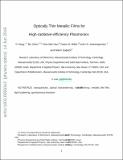Optically Thin Metallic Films for High-Radiative-Efficiency Plasmonics
Author(s)
Hsu, Chia Wei; Miller, Owen D.; Yang, Yi; Zhen, Bo; Soljacic, Marin; Joannopoulos, John; ... Show more Show less
DownloadSoljacic_Optically thin.pdf (2.206Mb)
PUBLISHER_POLICY
Publisher Policy
Article is made available in accordance with the publisher's policy and may be subject to US copyright law. Please refer to the publisher's site for terms of use.
Metadata
Show full item recordAbstract
Plasmonics enables deep-subwavelength concentration of light and has become important for fundamental studies as well as real-life applications. Two major existing platforms of plasmonics are metallic nanoparticles and metallic films. Metallic nanoparticles allow efficient coupling to far field radiation, yet their synthesis typically leads to poor material quality. Metallic films offer substantially higher quality materials, but their coupling to radiation is typically jeopardized due to the large momentum mismatch with free space. Here, we propose and theoretically investigate optically thin metallic films as an ideal platform for high-radiative-efficiency plasmonics. For far-field scattering, adding a thin high-quality metallic substrate enables a higher quality factor while maintaining the localization and tunability that the nanoparticle provides. For near-field spontaneous emission, a thin metallic substrate, of high quality or not, greatly improves the field overlap between the emitter environment and propagating surface plasmons, enabling high-Purcell (total enhancement >10[superscript 4]), high-quantum-yield (>50%) spontaneous emission, even as the gap size vanishes (3–5 nm). The enhancement has almost spatially independent efficiency and does not suffer from quenching effects that commonly exist in previous structures.
Date issued
2016-05Department
Massachusetts Institute of Technology. Department of Mathematics; Massachusetts Institute of Technology. Department of Physics; Massachusetts Institute of Technology. Research Laboratory of ElectronicsJournal
Nano Letters
Publisher
American Chemical Society (ACS)
Citation
Yang, Yi et al. “Optically Thin Metallic Films for High-Radiative-Efficiency Plasmonics.” Nano Letters 16.7 (2016): 4110–4117.
Version: Author's final manuscript
ISSN
1530-6984
1530-6992